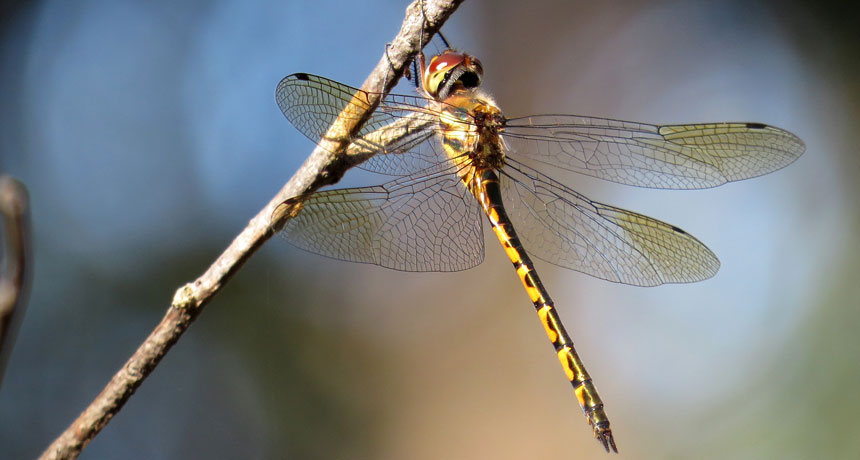Dragonflies, Strange Love

Grab, shake, bite, puncture, punch—that’s just the courtship ritual of these dazzling aerobats.
Get a taste of what awaits you in print from this compelling excerpt.
You may have seen their antics on a languid summer day: Somewhere on the reedy fringes of a pond, a male dasher dragonfly pursuing a female, like two hyphens of lightning. Or a tiger-striped spiketail diving, twirling, flashing its gossamer wings, then in a blink, meeting a mate to ascend together into the ether. Or a linked pair of brilliant green darners hovering as one over the dark water, the male towing the female, darting forward, then back, then straight up with the kind of aerial agility of which we masters of the helicopter can only dream.
From a distance, dragonfly rituals of courtship and sex look harmless, even romantic. But a close look at their mating game reveals a harsher tale of sexual harassment and conflict. Take the jewelwing Calopteryx splendens. Some males dispense with courtship altogether and just snatch unwary females while they’re warming in the sun—even immature ones, shimmer-fresh after emergence from their larval youth. Others, called “stealers,” attack and split mating pairs by ramming, pulling, and biting them; still others, “water lurkers,” grab a female in the midst of egg laying so they can have their way with her, even if she drowns in the process. Females, for their part, attempt to escape this boorish behavior by flipping, zigzagging, spiraling upward or downward, submerging in water, fleeing at high speed, or fighting back, sometimes murderously.
Why such a war between the sexes? Scientists seeking clues to the answer are finding in dragonflies a bizarre mix of cooperation and conflict, instinct and experience, which may explain not just their odd reproductive habits but also their dazzling diversity of colors and species calais villas.
When my grandmother was growing up, dragonflies were known as devil’s darning needles and horse stingers, considered an annoyance by some, a danger by others. In many places the insects are still under suspicion, dubbed finger cutter, horse killer, ear stick, and eye pisser. They are poisonous. They will sew together your lips. They will crawl into your ear and penetrate your brain. They will sting you. They will bite you. They will bring you rotten luck, or worse.
“Not so,” says Philip Corbet, a biologist from Cornwall in England. “Dragonflies are neither nuisance nor danger—that is, unless you’re a mosquito.” Or another dragonfly.
Corbet is fixed on a pair of elegant blue-tailed damselflies on the sunny bank of a small lake in Spain—one azure, one ocher, “both from the species Ischnura graellsi, renowned for having females of more than one color,” he says, and also, for the male’s distinctly “ungallant” behavior. “To secure a copulation, a male will seize a flying female and sometimes even bite her wings at the base.”
This pair, however, is locked in an embrace that can only be described as an ersatz heart.
Anyone who has watched dragonflies mating in the bright air has seen a wonder of evolution, Corbet says. Odonates, as they’re called, or “toothed ones,” have been around for more than 300 million years, which has given them time to figure all the angles on sex.